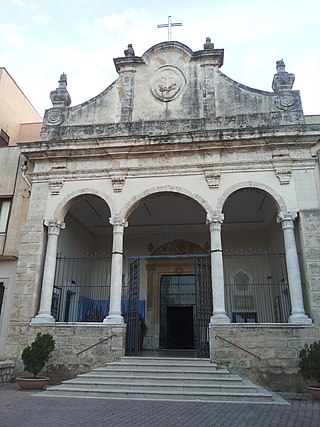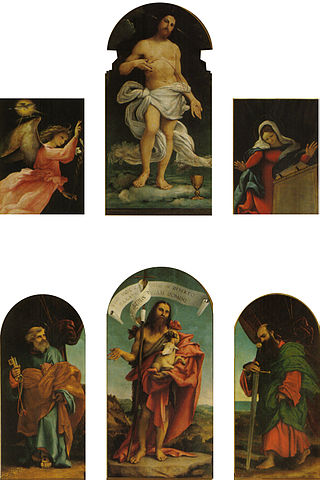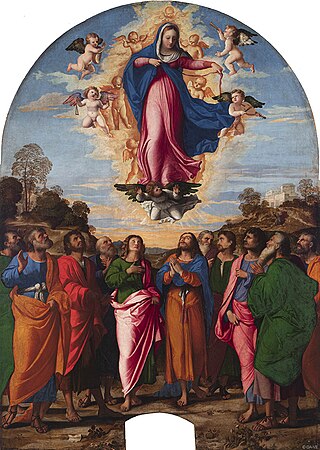Related Research Articles

Lorenzo Lotto was an Italian Renaissance painter, draughtsman, and illustrator, traditionally placed in the Venetian school, though much of his career was spent in other north Italian cities. He painted mainly altarpieces, religious subjects and portraits. He was active during the High Renaissance and the first half of the Mannerist period, but his work maintained a generally similar High Renaissance style throughout his career, although his nervous and eccentric posings and distortions represented a transitional stage to the Florentine and Roman Mannerists.

The Catholic Church in San Marino is part of the worldwide Catholic Church, under the leadership of the Pope in Rome.

The Archdiocese of Bologna is a Latin Church ecclesiastical territory or archdiocese of the Catholic Church in Northern Italy. The cathedra is in the cathedral church of San Pietro, Bologna. The current archbishop is Cardinal Matteo Zuppi, who was installed in 2015.

San Francesco di Paola is a prominent church located to the west in Piazza del Plebiscito, the main square of Naples, Italy. The construction started in 1816 and ended in 1846.

San Giorgio Maggiore is a 16th-century Benedictine church on the island of the same name in Venice, northern Italy, designed by Andrea Palladio, and built between 1566 and 1610. The church is a basilica in the classical Renaissance style and its brilliant white marble gleams above the blue water of the lagoon opposite the Piazzetta di San Marco and forms the focal point of the view from every part of the Riva degli Schiavoni.

Antonio d'Enrico, called Tanzio da Varallo, or simply il Tanzio was an Italian painter of the late-Mannerist or early Baroque period.

The Madonna dell'Orto is a church in Venice, Italy, in the sestiere of Cannaregio. This was the home parish of Tintoretto and holds a number of his works as well as his tomb.

The Church of San Marco in San Girolamo is a baroque parish church in Vicenza, northern Italy, built in the 18th century by the Discalced Carmelites. It houses various artworks by artists of the early 18th century from Veneto. The sacristy preserves its original furniture of the same period.

Antonio del Massaro da Viterbo, or Antonio da Viterbo, nicknamed il Pastura was an Italian painter.

The church of Santa Maria delle Grazie in Brescia is located on at the west end of Via Elia Capriolo, where it intersects with the Via delle Grazie. Built in the 16th century and remodeled in the 17th century, it still retains much of its artwork by major regional artists, including one of its three canvases by Moretto. The other two are now held at the Pinacoteca Tosio Martinengo. The interior is richly decorated in Baroque fashion. Adjacent to the church is the Sanctuary of Santa Maria delle Grazie, a neo-gothic work.

The Church of San Lorenzo in Piscibus is a 12th-century small church in the Borgo rione of Rome. It is located near Saint Peter's Square and Vatican City, but its façade is not visible from the main street, Via della Conciliazione.

The Sanctuary of Madonna dei Miracoli is a church in Alcamo, province of Trapani, Sicily, southern Italy; it is dedicated to the Madonna of the Miracles.

Santa Maria di Gesù is a Catholic church in Alcamo, in province of Trapani, Sicily, southern Italy.

San Bernardino in Pignolo is a Roman Catholic church located on Via Pignolo #59, in Bergamo, region of Lombardy, Italy.

The Ponteranica Altarpiece is a six-panel oil painting series produced by Lorenzo Lotto in 1522, commissioned by the Scuola del Corpo di Cristo for the parish church of San Vincenzo e Sant'Alessandro in Ponteranica, where it still remains. Its upper register shows the risen Christ flanked by an Annunciation scene, whilst below is John the Baptist flanked by saints Peter and Paul.

The Adoration of the Magi with Saint Helena is an oil painting on canvas of c. 1525–1526 by Palma Vecchio in the Pinacoteca di Brera, Milan.

The Assumption of the Virgin is an oil on panel painting by Palma Vecchio, created c. 1513, now in the Gallerie dell'Accademia in Venice.
The San Giacomo Altarpiece is a 1515 oil on panel painting by Palma Vecchio which hangs in the church of San Giacomo Maggiore in the Peghera district of Taleggio, Lombardy. It is also known as Pietà with Saint James, Saint Sebastian and Saint Roch.
Pietro Paolo Sensini was an Italian painter active in a Mannerist-style painting religious altarpieces mainly in his native city of Todi and nearby towns in Umbria.

The city of Vicenza is extremely rich in churches, monasteries, convents and other buildings intended for worship or religious activities, built during the seventeen centuries of Christian presence in the city.
References
- ↑ (in Italian) "Adorazione dei pastori". Beweb. Retrieved 25 March 2020.
- 1 2 (in Italian) "Adorazione dei pastori e san Rocco" . Retrieved 24 March 2020.
- ↑ (in Italian) "Monache francescane toe Montello" . Retrieved 24 March 2020.